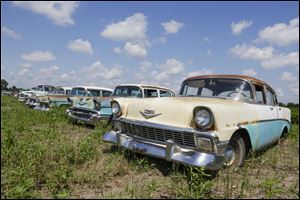
Americans driving less as car culture in U.S. stalls
Researchers divided on causes of trend
9/2/2013
Chevrolet automobiles are lined up in a field near the former Lambrecht Chevrolet car dealership in Pierce, Neb.
WASHINGTON — Driving in America has stalled, leading researchers to ask: Is the national love affair with the automobile over?
After rising for decades, total vehicle use in the United States — the collective miles people drive — peaked in August, 2007. It then dropped sharply during the Great Recession and has largely plateaued since, even though the economy is recovering and the population growing. Just this week, the Federal Highway Administration reported vehicle miles traveled during the first half of 2013 were down slightly, continuing the trend.
Ohio may be bucking the trend somewhat. The Buckeye state was one of only seven in which vehicle miles increased between 2005 and 2011.
Even more telling, the average number of miles drivers individually rack up peaked in July, 2004, at just over 900 per month, according to a study by Transportation Department economists Don Pickrell and David Pace. By July of last year, that had fallen to 820 miles per month, down about 9 percent. Per capita automobile use is now back at the same levels as in the late 1990s.
Until the mid-1990s, driving levels largely tracked economic growth, according to Mr. Pickrell and Mr. Pace, who said their conclusions are their own and not the government’s. Since then, the economy has grown more rapidly than auto use. Gross domestic product declined for a while during the recession but reversed course in 2009. Auto use has yet to recover.
Meanwhile, the share of people in their teens, 20s, and 30s with driver’s licenses has been dropping significantly, suggesting that getting a driver’s license is no longer the teenage rite of passage it once was.
Researchers are divided on the reasons behind the trends. One camp says the changes are almost entirely linked to the economy. In a few years, as the economy continues to recover, driving will probably bounce back, they reason. At the same time, they acknowledge there could be long-term structural changes in the economy that would prevent a return to the levels of driving growth seen in the past; it’s just too soon to know.
The other camp acknowledges that economic factors are important but says the decline in driving also reflects fundamental changes in the way Americans view the automobile. For commuters stuck in traffic, getting into a car no longer correlates with fun. It’s also becoming more of a headache to own a car in central cities, and downright difficult to park.
“The idea that the car means freedom, I think, is over,” said travel behavior analyst Nancy McGuckin.
Gone are the days of the car culture as immortalized in songs like “Hot Rod Lincoln,” “Little Deuce Coupe,” and “Pink Cadillac.”
“The car as a fetish of masculinity is probably over for certain age groups,” Ms. McGuckin said. “I don’t think young men care as much about the car they drive as they use to.”
That’s partly because cars have morphed into computers on wheels that few people dare tinker with, she said. “You can’t open the hood and get to know it the way you used to,” she said.
Lifestyles are also changing. People are doing more of their shopping online. More people are taking public transit than ever before. And biking and walking to work and for recreation are on the rise.
Social networking online may also be substituting for some trips. A study by University of Michigan transportation researcher Michael Sivak found that the decline in teens and young adults with driver’s licenses in the United States was mirrored in other wealthy countries that have a high proportion of Internet users.
Demographic changes are also a factor. The peak driving years for most people are between ages 45 and 55 when they are the height of their careers and have more money to spend, said transportation analyst Alan Pisarski, author of “Commuting in America.” Now, the last of the baby boomers — the giant cohort born between 1946 and 1964 — are moving out of their peak driving years.
There’s also a driving gender gap. In a role reversal, there are now more women than men in the United States with driver’s licenses. And the declines in miles driven over the past decade were more widespread among men than women, according to Mr. Pickrell and Mr. Pace. Driving by men has declined in every age group except those 65 or older, where it increased slightly. Among women, driving declined only among young adults and teenagers.